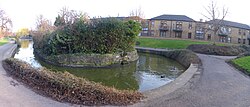Ranelagh
| Ranelagh Irish: Raghnallach | |
| County Dublin | |
|---|---|
 Ranelagh Gardens | |
| Location | |
| Grid reference: | O163319 |
| Location: | 53°19’31"N, 6°15’17"W |
| Data | |
| Post town: | Dublin |
| Postcode: | D6 |
| Local Government | |
| Dáil constituency: |
Dublin Bay South |
Ranelagh is a residential area and urban village on the south side of Dublin, in County Dublin.
The district was originally a village known as Cullenswood [1] just outside Dublin, surrounded by landed estates.
History
On Easter Monday in 1207, a celebrating group of English inhabitants of Dublin were attacked here by Irish raiders from County Wicklow. Three hundred people were said to have been killed.[2]
In the early years of the Irish Confederate Wars (1641–1649) the area was the scene of skirmishes culminating in the Battle of Rathmines in August 1649. After the Confederate rebels allied with Royalists against the Parliamentarians, an attempt was made to take Dublin. Their army under Ormonde was defeated, many of them killed, and the place where they fell (mainly between Rathmines and Ranelagh) was known for a long time as the Bloody Fields.[3]
The area was incorporated into the expanding city in the 19th century, after which massive development took place.[4]
The locality became known as 'Ranelagh' when a popular entertainment venue (now a public park) was established about 1770 and named Ranelagh Gardens after a similar venture of the same name in Chelsea in Middlesex.[5] The model and the name were also copied in other cities, including Liverpool, New York and Paris.[6] The original Ranelagh Gardens in Chelsea was built on the site of Ranelagh House, the London home of the Jones family, who took their title, Earl of Ranelagh, from lands in County Wicklow that had belonged to Fiach McHugh O'Byrne[7] sometimes described as Lord Ranelagh, because he was head of the Gabhal Ragnaill branch of the O'Byrne clan.[8]
In 1785, only two years after the first manned flight, Richard Crosbie successfully flew in a hot air balloon from Ranelagh Gardens to Clontarf.[9] The 225th anniversary of his flight was commemorated with a balloon flight from the same gardens on 23 January 2010 although due to adverse weather the balloon did not take off.
In the 1970s and 1980s, areas of Ranelagh were bought up with the intention of developing the sites as office space, during a boom period of such construction in the wider city. One development site, purchased in 1972 by Fergus Morton, was a former builder's yard near Athlumney Villas, a terrace of artisan houses. Morton employed Delaney McVeigh and Pike to draw up a plan for two large office blocks on the site. The site was sold with the planning permission a number of times until it was purchased by the Construction Industry Federation, who built the office blocks, completing them in 1983.[10]
On film and in popular culture
Lee Dunne's novel Goodbye to the Hill is set in Ranelagh.
The cover picture of John McGahern's The Pornographer is of Mount Pleasant Square.
The film Frank was partly filmed on Cowper Gardens and Park Drive of Ranelagh in 2013.[11]
Sport
- Gaelic football: Ranelagh Gaels
References
- ↑ Curtis, M (2012) Rathmines, The History Press Ireland, Dublin, p 25; Wren, Jimmy (1987) The Villages of Dublin, Tomar, Dublin
- ↑ Ware, Sir James (1705) The Antiquities and History of Ireland, A Crook, Dublin p 41
- ↑ F. Elrington Ball: A History of the County Dublin. 1903. Part II. page 103 et passim
- ↑ Curtis, M (2012), p 60
- ↑ Helen, Lloyd (2011) Ranelagh Gardens: A Comparative Case Study of Pleasure Gardens in 18th century Dublin and London, School of Architecture, University College Dublin
- ↑ V.L. Redway, "Handel in Colonial and Post-Colonial America (To 1820)" The Musical Quarterly 1935; Caldwell, Mark (2005). New York Night: The Mystique and Its History. (New York: Scribner's) p. 44. Layton-Jones, Katy; Lee, Robert (2008), Places of Health and Amusement, Swindon: English Heritage, pp. 4–6
- ↑ O'Brien, Conor (2000) Feagh McHugh O'Byrne, History Ireland, Vol 8 No 1
- ↑ Kelly, Deirdre (1995) Four Roads to Dublin: A History of Rathmines, Ranelagh and Leeson Street, O'Brien Press, Dublin p.60; Peter, Ada (1907) Sketches of Old Dublin, Sealy Briars and Walker, Dublin.
- ↑ Rice, Eoghan (2006-12-17). "First Irishman to take to the skies to be honoured". http://www.tribune.ie/2006/12/17/80332.html. Retrieved 2007-04-09.
- ↑ McDonald, Frank (1985). The destruction of Dublin. Dublin: Gill and Macmillan. pp. 249. ISBN 0-7171-1386-8. OCLC 60079186. https://www.worldcat.org/oclc/60079186.
- ↑ Maurice Curtis (2017). "12". The Little Book of Ranelagh. History Press. p. 168. ISBN 978-0-7509-8512-3. https://books.google.com/books?id=Y3ssDwAAQBAJ.